Tapestry tabula of linen and wool with a representation of a woman adorning herself in front of a mirror. These decorative textiles were sewn into garments - 5th-6th Century
Tapestry medallion of linen and wool from a wall-hanging representing Pegasus. Although the subject is borrowed from Greek mythology, the decorative details reveal a Sassanian influence - 6th Century
Tapestry fragment of a woollen wall-hanging with the portrait of a female deity and an inscription. The expressiveness of the face, the richness of the colours and the decorative elements are reminiscent of the large wall-hangings of late antiquity - 3rd-4th Century
Tapestry decoration of a shawl made of linen and wool, representing Dionysus framed by a vine. The theme originating from the Greco-Roman mythological repertoire, was transformed into a Christian symbol for hope for life after death - 4th-5th Century
Tapestry fragment of a wall-hanging of linen and wool decorated with the personification of Spring
4th Century BC
Tapestry fragment of linen and wool that adorned a curtain or wall-hanging. In spite of the worn condition of the material the composition representing peacocks and flowers retains its vivid polychromy - 4th Century
Linen and woolen screen curtain in the loop weave technique, with representation of a praying couple.
From Antinoe, Egypt - 5th-6th Century
Fragment of a linen tunic band, decorated with a grid pattern of lozenges and medallions with symmetrical motifs. From Egypt - 8th-9th Century
Gold thread embroidered Aer, a liturgical cloth used to cover the vessels of the Eucharist. Depicted is a symbolic representation of the Communion of the Apostles. The piece is one of the oldest and best preserved pieces of Byzantine gold-thread embroidery - Late 13th Century
White embroidered linen cloth, a covering for the Holy Altar, with a representation of Christ as the Judge of the Apocalypse, framed by the Virgin, St John the Baptist and angels.
Dalmatian or German workshop - 15th Century?
Bridal costumes from Episkopi, western Macedonia
Bridal costume from Baltza, central Macedonia
Rare embroidery with dense gold thread embroidered floral motifs.
From Asia Minor - 17th-18th Century
Bridal costumes from Kavakli, northeastern Thrace
Female costume from Makra Gefyra, eastern Thrace
Bridal costume from Kapoutzida, central Macedonia
Various costumes
Embroidery with floral decoration of gold and coloured threads.
From Asia Minor - 19th Century
Female costume from Samsun in Asia Minor
Female costume of Constantinople, reconstituted from various garments
Bridal costume from the area of the Pontos (Black Sea)
Female festive costume from Cappadocia area
Female festive costume from Delmissos of Nigde at Ikonion, Asia Minor
Bridal costume of Silli at Ikonion, Asia Minor
Female festive costume from Vathy on Samos
Embroidered cushions with stylized floral decoration, from Chios - 19th Century
Female festive costume from Mytilini
Embroidered cushions with stylized floral decoration from Chios - 19th Century
Rare costume of Thassos, with a dress made of 16th-17th century Bursa gold-woven fabric and the date 1775 gold-embroidered on the sleeves of the chemise
Male costume from Pyrgi on Chios
Gold thread embroidered shoes from various regions.
Female festive costume from Pyrgi on Chios.
Bridal costume from Kalamoti on Chios
Embroidered cover - from Asia Minor 17th-18th Century
The embroidered composition of tulips, carnations, and leaves reproduce designs from the renowned silk fabrics of Bursa
Bridal sheet from Skyros, Sporades, 18th Century
The borders of the sheet are embroidered with a frieze of hoopoes which have been rendered with an imaginative freedom of design, a naturalistic spirit and an impressive chromatic variety
Bridal sheet from Skyros, Sporades, 18th-19th Century
The embroidered borders of the sheet depict riders, flower vases, and animals, subjects taken from the repertoire of Epirote embroidery.
Fragment of a bridal sheet from Skyros, Sporades - 18th Century
The embroidery depicts two female figures.
Various costumes
Female festive costume from Trikeri, Magnesia reconstituted from various garments
Bridal costume of Skyros, Sporades, reconstituted from various garments
A child's and a man's costume from Skyros, Sporades
Female festive costume from Skopelos, Sporades
Embroidery representing a rider brandishing swords, framed by flowers, a subject familiar from Italian ceramics - from Skyros, Sporades - 17th Century
Bridal costume from Skiathos, Sporades
Embroidered bed valances, examples of Cycladic needlework from Anaphi. They are distinguished by the pronounced stylization of the decorative motifs.The bed valance that bears a frieze with repetitive female figures between trees with birds and deer is one of the earliest known examples.
White embroidered towel with ships, sailors, animals and a tree of life. White embroideries form a group of their own and are to be mainly found on the islands; they usually feature abstract and geometric patterns. From the Cyclades - 18th-19th Century
Sperveri - A rare kind of tent which isolated the sleeping platforms from the lower sitting area and hid the bridal bed from prying eyes. This is the best preserved and most spectacular of the few comparable surviving examples from the Dodecanese. The polychromal vegetal motifs, vases and peacocks are worked in the Dodecanesian raised stitch. Its workmanship combines sumptuousness of style with excellence of execution, austere compilation of an overall pattern with echoes of Byzantine splendour and Neo-Hellenic aesthetic orientations. From Rhodes - 17th-18th Century
Bedspread from Naxos, Cyclades - 17th-18th Century
Embroidered in red with geometric designs, the bed cover is a typical example of the decorative style of Naxian needlework.
Wood carved loom from Crete - early 19th Century
Woven sheets from Crete - 19th Century
Dense loom woven embroidery with geometric motifs in vivid colours. Outstanding among them is an example with a representation of dance.
Bedspread from Crete - late 17th-early 18th Century
Embroidered all over with vegetal and floral motifs, birds and heraldic animals, this bedspread is a rare if not unique example of what formerly adorned the bridal bed in Crete.
Central panel of a sperveri from Patmos, Dodecanese - 17th-18th Century
Porteria, the central opening of a gold thread embroidered tent for the bridal bed. Small stylized figures appear amidst a host of decorative motifs, while at the top is depicted the age old motif of the woman at the window of her home.
Embroidery for a bridal bed from Astypalaia, Dodecanese - 18th Century
Known as a stylomantila it adorned bedposts. The bi-chromatic needlework represents a praying female figure flanked by double headed eagles, imaginary beasts, angels, women dancing, warriors and vegetal motifs.
Loom woven bedspread from the Rethymnon area, Crete - 19th Century
Kilim from Siteia, Crete - late 18th Century
Flatweave with geometric designs
Part of an embroidery depicting a woman on a floral ground and a musician in breeches playing his lute. From Crete - 17th Century
Female costume, a rare survivor of a type of costume that had it's origins in a Western Renaissance style and was to be found in the Aegean islands during the occupation of the Franks.
From Crete - 17th Century
Parts from embroidered hems of costumes from Crete, with double-headed eagles, flower vases, birds, mermaids and vegetal motifs - 17th-18th Century
Boy's costume from Crete
Male costume from Crete
Embroidered cushion with a representation of a mermaid, in the same style as the embroideries on the Cretan garments. From Crete - 17th-18th Century
Part of a woollen bedspread woven with a design of a couple on the tree of life.
From Kritsa, Crete - 18th-19th Century
Bedding from Crete
Bridal sheet with red monochrome embroidery, from Cyprus - 17th-18th Century
Red monochrome embroideries for bedecking the bridal bed, from Cyprus - 18th Century
Female costume from Karpasi, Cyprus
Female urban costume of Cyprus
Chemise with geometric raised embroidery, from Karpathos, Dodecanese - 18th Century
Bridal costume of Astypalaia, Dodecanese











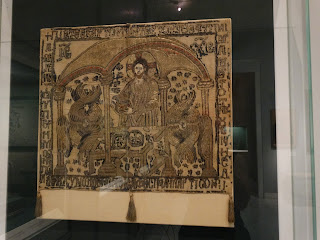







































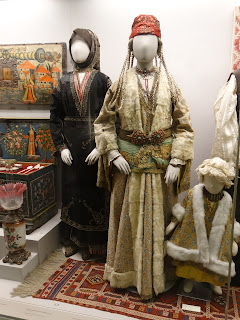













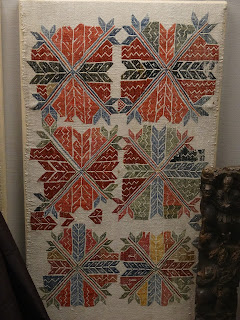














































































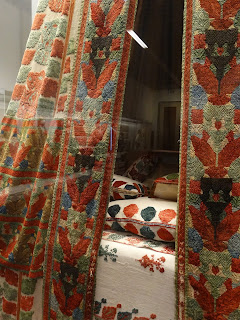















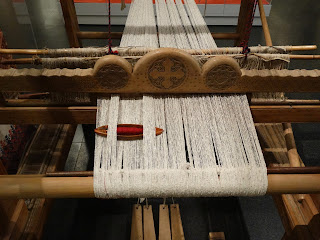












































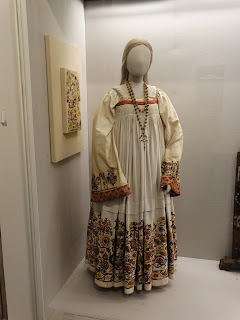


































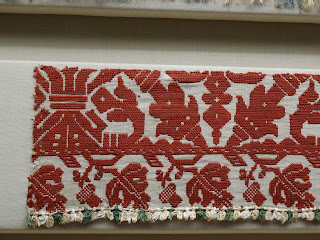

























No comments:
Post a Comment